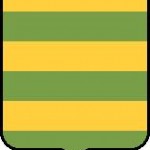Ezzelini da Romano
Ezzelini da Romano or Ecelini da Onara
Family of Germanic origin descended in Italy following the Emperor Corrado II in the XI century
Ezzelini da Romano: It seems that the head of Ezzelini’s family is Arpone or Arpo and some documents show that the family professed Salic law (Franc legislation of King Clodoveo in V century and then revised by Carlo Magno), according to some chroniclers of the time following the Emperor Corrado II between 1024 and 1039. Between 1035 and 1199 the family settled in the castle of Onara (fraction of Tombolo, now province of Padua) from which, in the documents of the time, it is found as Ecelini de Onara. Later, with the destruction of the castle, they moved to the land of Romano (Treviso), becoming Ezzelini da Romano.
 Ecelo I degli Ezzelini (about 1015 – after 1091), According to the chronicler Rolandino da Padova, he arrived in Italy following the emperor Corrado II, who named him Castellan of Onara and of Romano; he then received the castle of Bassano from the bishop of Vicenza. From marriage to Gisla, a noblewoman of Lombard law, had Ecelo II and Alberico I.
Ecelo I degli Ezzelini (about 1015 – after 1091), According to the chronicler Rolandino da Padova, he arrived in Italy following the emperor Corrado II, who named him Castellan of Onara and of Romano; he then received the castle of Bassano from the bishop of Vicenza. From marriage to Gisla, a noblewoman of Lombard law, had Ecelo II and Alberico I.
Ecelo II degli Ezzelini (……………), castellan of Onara, of Romano, of Bassano and in 1160 the bishop of Frisinga awarded him the Godego Castle.
Alberico I degli Ezzelini (……- before then 1154), Married to Cunegonda of longobard origin from which Ecelino I had.
Ecelino I degli Ezzelini called “Balbo” (stutterer) ( …… – after 1180), Married to Auria, daughter of Count Baone, had: Giovanni, Ecelino II, Cunizza IIa, Gisla. Castellan of Onara, Romano, Bassano, Godego. In 1173 is podestà of Treviso and Vicenza. In 1175 he was commander of the Lombard part of Guelph, against Emperor Frederick I Barbarossa; Participates in the Second Crusade. After reconciliation with the emperor, go to the Ghibellines.
Ecelino II degli Ezzelini or Ezzelino II called the “Monk” (…. -1235), he marries four times: Agnese d’Este; with Speronella Dalesmanni in 1170 who abandoned him; with Cecilia the daughter of Manfredo Count of Abano; Adelaide in 1184, of counts of Mangona and Guidi. From the first and fourth marriages he had: Palma, Agnese, Palma Novella, Ecelino III the “Terrible”, Alberico II, Emilia, Sofia, Cunizza III (who married: count Riccardo Bonifacio, Sordello Visconti, Bonio da Treviso, Rainerio da Breganze , a noble whose name is unknown), Adelasia (illegitimate), Ziramonte (illegitimate). In 1198 Pope Innocent III commissioned the Patriarch of Aquileia, Pilgrim II, to resolve a dispute between Ecelino II and the monastery of Sesto al Reghena regarding the ownership of some lands that had led to the excommunication of Ecelino II. 1191 – 1193 Podestà of Treviso, 1200 Podestà of Verona, 1211 Podestà of Vicenza. In 1199 the castle of Onara was destroyed by the Padovans for resting, in 1209-1210 he obtained Bassano from Emperor Ottone IV; in 1221 he retired to the convent of Oliero first and Campese later leaving power to his sons Ezzelino III and Alberico.
Ecelino III degli Ezzelini or Ezzelino the Tyrant (Onara 1194 – Soncino, September 27, 1259), 1221 married Gilia of St. Boniface but repels her; 1258 Selvaggia daughter of Emperor Federico II; 1244 Isotta Lancia; Betarice di Castelnuovo; it seems had a single son Peter, imprisoned in 1246 in the castle of Angarano. Lord of Verona from 1226 to 1233. From 1232 Lord of Bassano; from 1235 Castellano of Romano and Godego; from 1236 to 1259 Lord of Verona and in 1237 Imperial Vicar of Verona.
Alberico II degli Ezzelini (executed in Treviso on August 26, 1260), married in 1220 with Beatrice from whom he had: Adelaide, Ezzelino IV, Giovanni, Alberico, Romano, Ugolino (last four executed with his father in Treviso in 1260); by his second wife Margherita, he had: Griseida, Tornalasce, Amabilia (burned with mother and father on the same day). Castellan of Romano and Podestà of Vicenza 1227 and Treviso from 1240 to 1257. With the execution of Treviso, it ended the Ezzelini da Romano dynasty.
